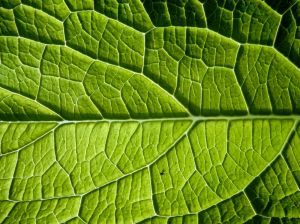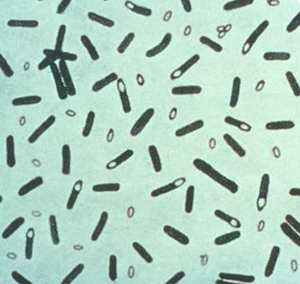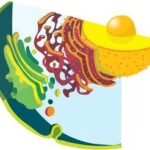Eukaryotic cells are found in every domain with the exception of the Bacteria and Archea domain. Eukaryotic cells differ from prokaryotic cells in two major ways; size, and the presence of a membrane surrounding the nucleus, and other organelles. Because eukaryotic cells are so much larger than prokaryotic cells (roughly ten times larger) it becomes necessary for the cells to be divided internally by membranes in order for the cell to be able to sustain itself. Within these divisions of the cell, the organelles are contained.
Nucleus
One of the major distinguishing features between a prokaryotic and eukaryotic cell is the presence of a nucleus. Eukaryotic cells contain a clearly defined membrane that surrounds the nucleus which holds the genetic material of the cell. Prokayotic cells contain their genetic material to one area of the cell, known as a nucleoid, however, this material is not bound or confined by a membrane.
The nucleus is responsible for housing the DNA and genetic information within the cell. The nucleus is contained within what is called the nuclear envelope, a semi-permeable membrane lined with nuclear pores that allow the passage of ions and small molecules, made up of two lipid bilayers. Each molecule of DNA is considered one chromosome. A total of 46 chromosomes can be found in human DNA.
Within the nucleus of most cells, distinct regions can be found. A specific region, known as the nucleolus is responsible for the production of a specific type of RNA known as rRna.
Endoplasmic Reticulum
The endoplasmic reticulum is a large, complex network of tubes and deflated or flattened sacs. The endoplasmic reticulum is contained by a single membrane that is often connected to the outermost membrane of the cell, allowing the endoplasmic reticulum plenty of space, referred to as cisternal space or the lumen. Within the endoplasmic reticulum, certain sections of the membrane branch out into rounded sacs called transport vesicles. Transport vesicles specialize in the transportation of substances within the cell as well as transport of substances to the exterior of the cell. Vesicles are small, enclosed by a membrane, and have a variety of functions, including the storage and breakdown of macromolecules.
There are two types of endoplasmic reticulum; the smooth endoplasmic reticulum and the rough endoplasmic reticulum. The rough endoplasmic reticulum is primarily responsible for the production of proteins, while the smooth endoplasmic reticulum is responsible for the transport of these proteins. The smooth endoplasmic reticulum makes up a much smaller portion of the endoplasmic reticulum than does the rough endoplasmic reticulum. In some cells, however, the smooth endoplasmic reticulum is more abundant, such as cells of the liver or muscles.
Golgi Apparatus
The golgi apparatus is a membranous structure dedicated primarily to the processing and transportation of proteins manufactured within the endoplasmic reticulum. The golgi apparatus is responsible for the “sorting” of proteins, before transporting these proteins to their destination within or outside of the cell.
If the golgi apparatus were to be inspected under a microscope, it would appear as a large series of flattened tubes stacked upon one another, with transport vesicles surrounding.
Lysosomes
Lysosomes are found in nearly every animal eukaryotic cell. Lysosomes store enzymes manufactured by the rough endoplasmic reticulum. These enzymes aid in the digestion and breakdown of substances. Lysosomes, with their highly acidic interior, are responsible for breaking down substances, such as food, or even the cell itself after it dies. Plants contain an organelle known as a vacuole that performs many of the same digestive functions of the lysosome.
Peroxisomes
Peroxisomes are quite similar to lysosomes, however, they contain enzymes not manufactured within the golgi apparatus. Peroxisomes use molecular oxygen to oxidize organic molecules within the cell. The chemical reactions of doing so create hydrogen peroxide, which is then broken down into water and oxygen by an anzyme known as catlase. These organelles are present in nearly every cell, however, are especially abundant in cells located in the liver and kidneys.
Centrioles
Every animal-like cell contains two centrioles. The centrioles are made up of microtubules and play a key role in the process of meiosis and mitosis. The two centrioles lie perpendicular from one another within an area of cytosol known as the centrosome.
Mitochondria
Most eukaryotic cells contain an organelle known as the mitochondrian, or in plural form, the mitochondria. In the majority of eukaryotic cells, mitochondria act as the sole source of energy within the cell. Mitochondria are capable of providing energy by converting the energy found within food molecules into a form usable by the cell, known as ATP.
Mitochondria are shaped much like a bean and is contained by a double membrane. The innermost area of the mitochondria is known as the cristae and is composed of several large folds. The space even more inner than the cristae is called the matrix.
Chloroplast
Organisms such as plants, protists and fungi do not contain mitochondria to provide the cell with energy. Rather, these organisms contain a special organelle known as chloroplasts. Chloroplasts, much like mitochondria, are enclosed in a double membrane. Within the chloroplasts, more membranes are “stacked” upon one another. Each stack of membranes is called a granum, and each single layer in a stack is called a thylakoid. Within the thylakoid, chlorophyll can be found. Chloroplasts are capable of capturing energy from sunlight and converting it into chemical energy usable by the organism. Light energy is trapped by a substance known as chlorophyll located within the thylakoid and is then used to assemble sugars from carbon dioxide and water. This process is called photosynthesis.
References
Cain, Michael L., Carol Kaesuk Yoon, and Anu Cundy. Discover biology . 4th ed. New York: W.W. Norton & Co., 2009. Print.
Cell Organelles: The Nucleus and the Nucleolus
Eukaryotic Cell Biology Resources
Smooth Endoplasmic Reticulum
The Golgi Apparatus
Lysosome
Lysosomes: Little Enzyme Packages
Cell Organelles: Mitochondria
Photosynthesis
What is a Peroxisome?
Centrioles



